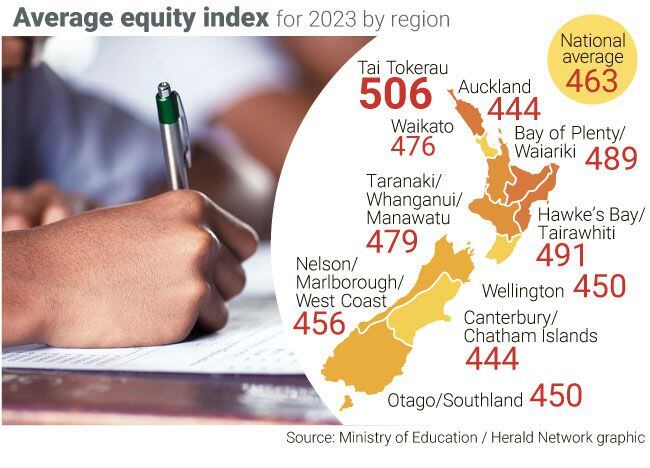Families with students in Te Tai Tokerau are faced with financial barriers as the cost of living crisis takes hold. Photo / 123rf
The cost of living crisis is hitting hard across many facets, and education is not exempt, with Northland the most in-need region when it comes to equity funding for schools.
Expensive uniforms, school lunches, climbing
rent costs, stationery and fuel to get to school are just some of the costs parents and caregivers are having to grapple with as inflation takes hold.
Te Tai Tokerau Principals’ Association chairman and Hora Hora Primary School principal, Pat Newman, said the cost of living crisis “had an effect last year, and it’s having an effect this year”.
He said choosing between putting petrol in the car and half a kilogram of butter is a “very big decision” for a lot of families.
While the school lunch initiative – Ka Ora, Ka Ako – has made it easier to keep eligible students’ bellies full, the stress that economic pressure places on families has a big impact.
“We all know that the biggest stress in any relationship is finances,” Newman said, “and when that’s going on, that effects the child’s learning.”
Newman also noted that while the cost of living has disproportionately impacted lower-income families and those in poverty in the past, the gap between them is now closing.
“[The impact is] now spreading wider and wider,” he said.
Advertisement
Tai Tokerau is set to receive the most equity funding in schools out of any other region this year, as the region with the highest Equity Index (EQI).
The school decile system was phased out last year and replaced by the EQI, which allows better allocation of equity funding. Higher EQI numbers highlight a larger number of students facing greater socio-economic barriers.

Newman told the Northern Advocate the new system is “the best thing since sliced bread”.
“The previous system was a help, but this one is a lot more targeted,” he said.
Newman said the Government has “finally listened” to what he described as 30 years of pushing from principals and teachers in Tai Tokerau.
“They’ve listened, and I think they’ve put their money where their mouth is.”
/cloudfront-ap-southeast-2.images.arcpublishing.com/nzme/EJODWGQ7PZAWFDOGJTVNKFBFLA.JPG)
Second-hand uniforms and funded school lunches are among the options that parents and caregivers can explore which may reduce the cost of schooling, but Newman said even then, he’s aware of one school that spent $18,000 on food vouchers for families last year.
“This shouldn’t be necessary,” he said, “[but] that’s the situation many of our families are in.”
Advertisement
The financial struggles students and families in Northland go through is something I Have a Dream Charitable Trust is all too familiar with.
The trust works with just over 900 rangatahi in Ōtangarei and Tikipunga across four kura, offering extra opportunities to children through mentoring, tutoring and life coaching throughout their school years.
It’s the eighth year of operation for the trust, and CEO Chris Twiss said the cost of living has become an “additional significant challenge” for those communities.
“It’s contributing to making things more challenging and more difficult for whānau and youth,” he said.
Among a range of flow-on effects from the economic difficulties of 2022 and 2023, Twiss noted increased costs ultimately impact households and whānau themselves, which he noted “flows through” into behavioural challenges within the school setting.
Twiss said he wasn’t surprised that Te Tai Tokerau has the highest EQI, especially with “embedded inequity” within communities.
He said the increased cost of living, “relatively speaking”, hits those who are in the lower socio-economic bracket “much harder and faster.”
“Then that disadvantage is amplified,” he said.
Work and Income regional commissioner for Northland, Graham MacPherson, said beneficiaries or those in low-income households may be eligible for help paying with school uniforms and stationary.
“We know this time of year can be tough,” he said.
According to MacPherson, as of December 2022, there were 12 households in emergency housing in Northland.
While there is no data to highlight how many children and/or youths are included in this statistic, the monthly housing update from the Ministry of Social Development highlighted that 40 per cent of households in emergency housing are single parents with children.
Laster year, the Government also announced an increase to income limits for hardship assistance, with the changes targeted at families struggling with the cost of living.
Weekly income limits for couples (with or without children) have almost doubled, rising from $858.72 to $1,695.18.




